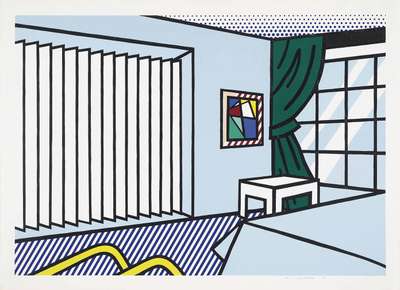A Collector’s Guide to Framing Art Prints & Editions

 Painting In A Gold Frame © Roy Lichtenstein 1984
Painting In A Gold Frame © Roy Lichtenstein 1984MyPortfolio

Key Takeaways
Framing art prints and editions correctly is essential for preserving their value, longevity, and aesthetic appeal. Choosing the right frame material, such as wood or metal, can enhance the artwork, while custom-made frames offer better protection for unique pieces. Archival framing techniques, including the use of acid-free mats and UV-protective glass or acrylic, are crucial for preventing damage from light and acid exposure. Proper mounting methods, such as reversible hinging or dry mounting, protect the artwork while displaying it beautifully. Handling prints with care, using cotton gloves, and consulting professional framers help prevent damage. Lastly, ensuring optimal display conditions by controlling humidity, air quality, and light exposure safeguards your collection from environmental harm. Investing in high-quality framing and maintenance will protect and preserve the condition and value of your art collection for generations.
Once you have bought your print, preserving its aesthetic, value and longevity is essential. Without careful consideration, improper framing can result in the long term damage and deterioration of a print, therefore understanding the nuances of appropriate framing is crucial. This involves comprehensive knowledge of correct materials, archival techniques, mounting methods and proper handling to ensure your print is protected. Selecting the help of specialists will make the process of framing stress-free, and provide you access to a network of reputable professional framers.
Choosing the Right Frame
Choosing a complimentary material for your frame is a crucial factor in the aesthetic appeal of your piece, and can greatly elevate the impact of your artwork. There are a variety of options available and prices can vary greatly. The cheapest option is resin, but wood, silver and gold offer pleasing, albeit more expensive, alternatives. Wooden frames are often chosen for their classic look, and provide a warmth and elegance often suited to traditional art, whereas metal frames offer a sleek modern feel to a piece, and are a favourite with contemporary and abstract art. If you are uncertain of which material to opt for, matching the frame style with surrounding home decor, considering colour, style and texture, can help guide your decision.
With valuable, uniquely sized, or highly sentimental prints, a buyer might decide to purchase a custom-made frame. Extensive customisation can be an attractive option, as tailoring a frame to fit a print’s specific dimensions can magnify a print’s visual appeal, and most effectively protect the print’s specific vulnerabilities. On the other hand, ready-made frames are much cheaper, but their availability and convenience are countered by limited sizes and lower levels of protection.
Archival Framing Techniques
Whilst a frame’s material will not impact the condition of a print, an acidic mat can cause damage. A mat is a thin piece of card or paper that separates the print from the frame, and offers a border between the artwork and frame. Using acid-free archival grade materials will prevent any discolouration or deterioration of a print, and offers a protective barrier between the print and frame, preserving the print’s longevity.
The most common material for mats is regular paperboard made from acid-neutralised wood pulp. This is a popular option as it has a service life of around 100 years, and is a more affordable option than an archival mat board. While an archival mat offers the highest level of protection, this ph-neutral material is also the most expensive.
UV protection glass and acrylic are essential in protecting your print from light exposure damage, which can cause fading and discolouration, and significantly decrease the artwork’s condition and value. Specialist glass or acrylic frames are particularly important if your print is displayed for long periods of time, or in outdoor spaces, so selecting the right type of glazing is crucial. The first type is UV filtering glass (or museum glass), which offers 97% protection and is especially fragile and expensive. Acrylic (Plexiglass) is a preferred option, as it is more affordable, lightweight and shatterproof, and offers 99% UV protection.
Mounting Methods for Art Prints
Proper mounting methods not only showcase your print, but are essential in protecting your artwork from damage. Hinging is a technique that is used for more valuable pieces, and involves attaching a mat using hinges or small pieces of tape, offering a reversible mounting option. Dry mounting, on the other hand, adhesively attaches the print to the backing, which provides a wrinkle-free, secure and permanent option. When choosing which technique to use, you must ascertain whether or not you will need to undo a print’s mounting and whether the artwork is signed or not.
It is integral to the conservation of a print that all materials used in the mounting process, including tapes, adhesives and corners, are archival grade and acid-free to prevent damage and preserve the artwork’s condition and longevity.
Handling & Preparing Prints for Framing
The objective of proper handling is to ensure a print avoids any damage in the process of cleaning or transport. Always handle prints with clean hands or cotton gloves to avoid fingerprints, and practise extra care with fragile or large prints, supporting them fully. Before moving a print, complete a condition report to map any new or existing weaknesses, and have the work transported by a reputable company that has established art handling experience. When cleaning your print, consult a specialist beforehand and use a soft brush to remove dust gently.
Professional Framing Services
Due to the delicate nature of prints, consulting a specialist and finding a reputable framer with experience in handling high-value art can provide the best framing advice. This will ensure high-quality, durable results, however costs do vary based on materials and customisation.
Browse TheDirectory to find framers in your area recommended by us.
Displaying and Maintaining Framed Prints
A framed print’s condition can be severely jeopardised if it is displayed in unsuitable conditions, and affect its provenance and value, therefore caring for your print is essential. Humidity, moisture and fluctuating temperatures are major contributors to conservation issues, and UV radiation from direct sunlight and harsh lighting causes visual discolouration and deterioration over a short period of time. Air quality is also a recognised challenge, and pollutants and particulates in the form of acidic materials, dust and insects are damaging to the condition of a print. Optimising display conditions by maintaining stable temperatures, humidity, air quality and low light exposure will greatly preserve an artwork’s longevity.
Choosing the right frame, material and style can significantly enhance the visual appeal of your artwork and conserve its condition and investment value. Implementing archival framing techniques, such as using acid-free mats and UV protective glazing, will safeguard your prints from deterioration. Proper mounting methods, handling, and preparation are vital for preserving the integrity of the artwork. Consulting professional framers and ensuring optimal display conditions will further protect your prints from environmental damage. Investing time and resources into quality framing and maintenance will not only enhance the beauty of your art collection but also ensure its preservation for years to come. Ensuring your framed art is in the best possible condition maintains its value and enjoyment across generations.


















































